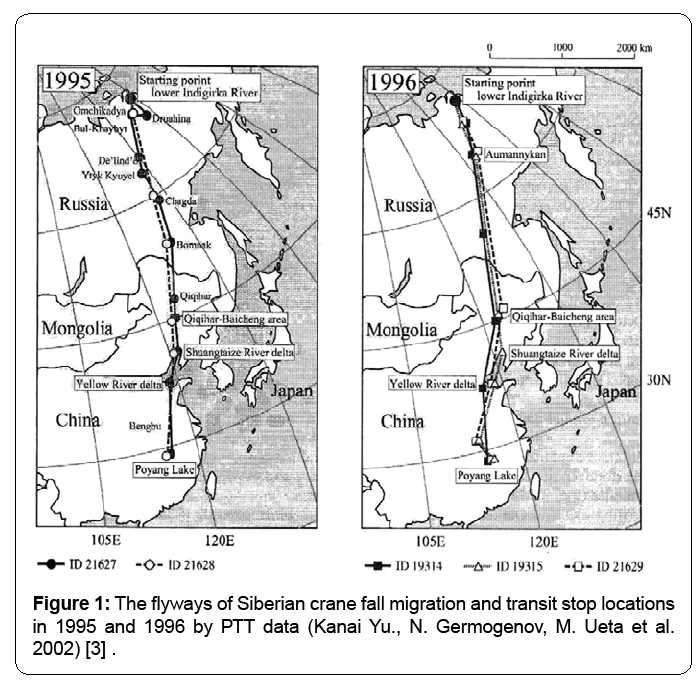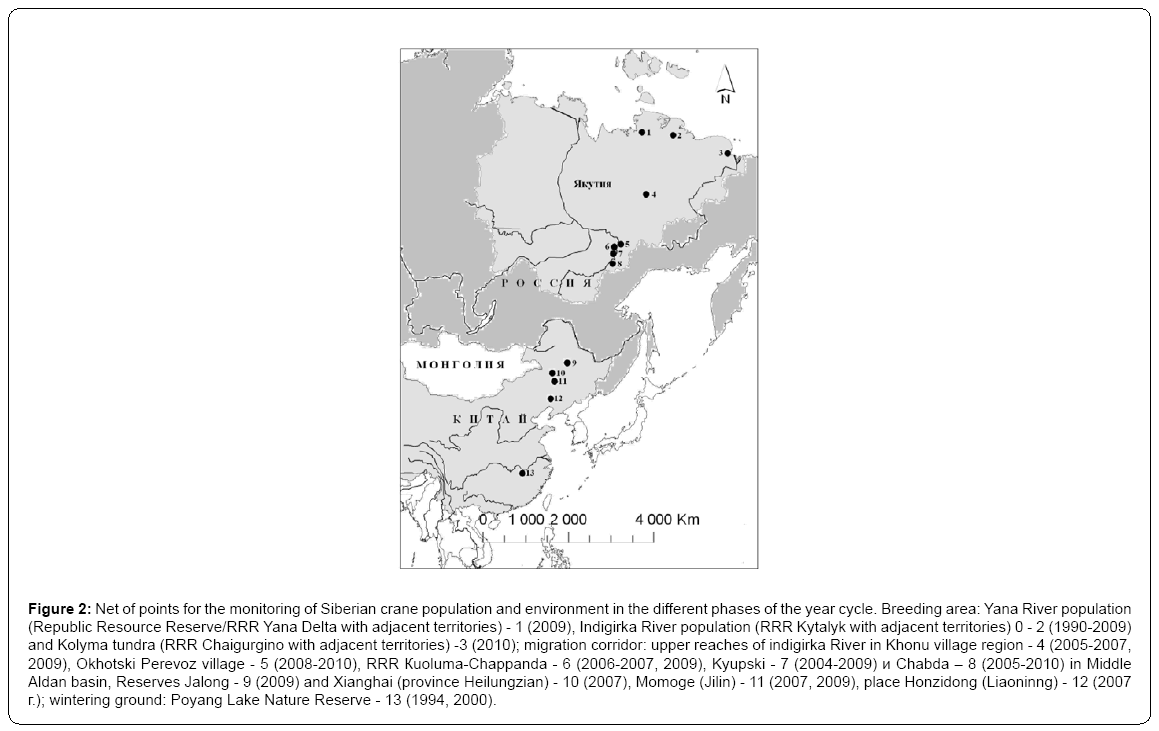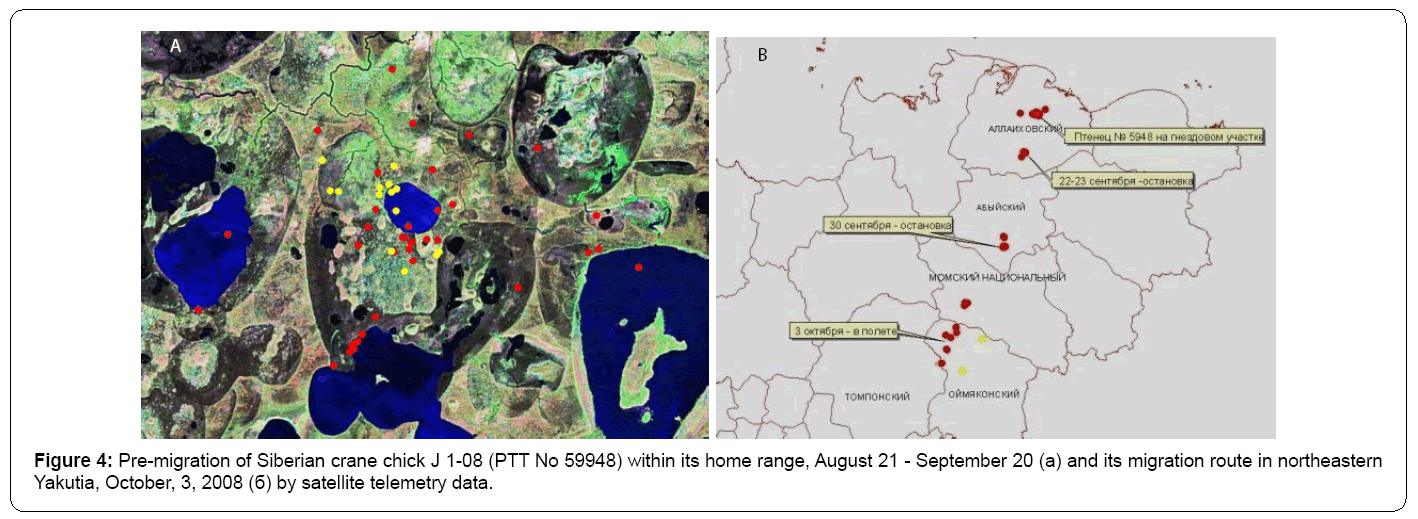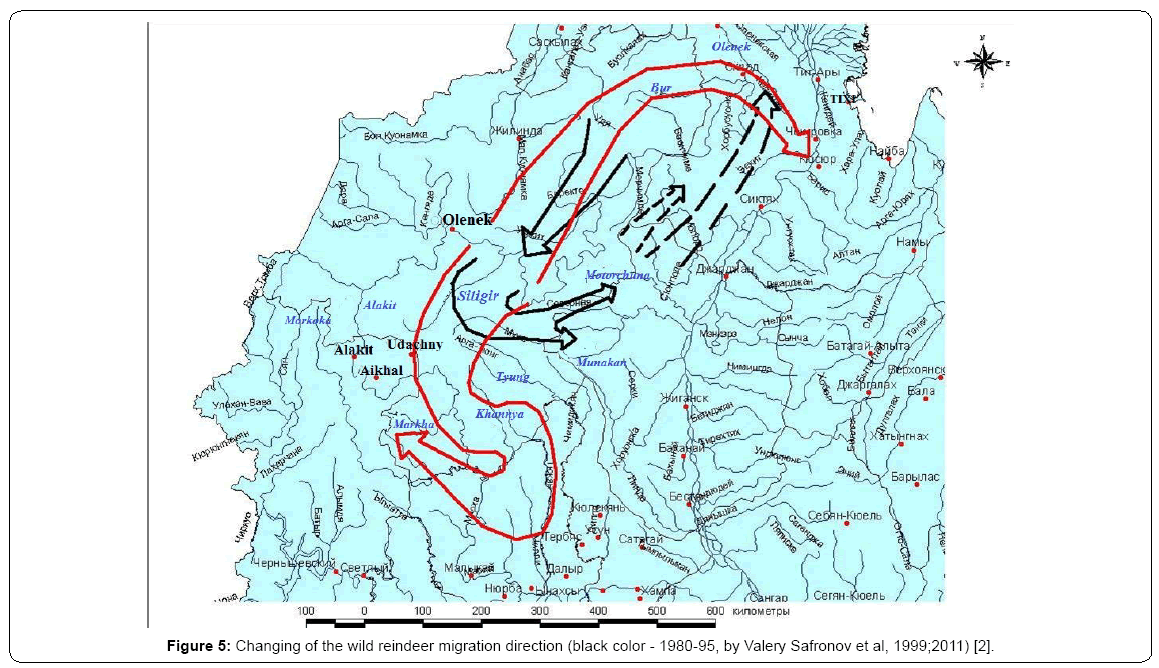Short Communication Open Access
Satellite Techniques Use in Study of Ecology and Migration of Animal in Yakutia (Northeast Asia)
Germogenov NI1,2*, Okhlopkov IM1, Solomonov NG1,2, Tatsudzava S3, Kirillin RA1, Nikolayev EA1 and Vladimirtseva MV11Department of Russian Academy for Sciences, Institute for Biological Problem of Cryolithozone under Siberian, Russia
2North-East Federal University, Yakutsk, Russia
3Graduate School of Letters, Hokkaido University, Japan
- *Corresponding Author:
- Germogenov NI
Institute for Biological Problem of Cryolithozone under Siberian
Department of Russian Academy for Science, Russia
Tel: +74112336471; 89246612855
E-mail: bio@ibpc.ysn.ru, sterkh-yrcu@mail.ru
Received date: October 05, 2013; Accepted date: December 10, 2013; Published date: February 06, 2014
Citation: Germogenov NI, Okhlopkov IM, Solomonov NG, Tatsudzava S, Kirillin RA, et al. (2014) Satellite Techniques Use in Study of Ecology and Migration of Animal in Yakutia (Northeast Asia). J Ecosys Ecograph 4:141. doi:10.4172/2157- 7625.1000141
Copyright: © 2014 Germogenov NI, et al. This is an open-access article distributed under the terms of the Creative Commons Attribution License, which permits unrestricted use, distribution, and reproduction in any medium, provided the original author and source are credited.
Visit for more related articles at Journal of Ecosystem & Ecography
PTT (Platform transmitter terminal) was first used in Yakutia, northeastern Russia, in August 1992 to reveal routes and speed of migrations, important transit stops and wintering grounds of the rare and endangered species of the World fauna, Siberian crane Grus leucogeranus Eastern (Yakutian) population [1] (Table 1).
| № | Species | Year | Number | Main participants | ||
|---|---|---|---|---|---|---|
| With РТТ | Banded | Foreign | Russian | |||
| 1. | Siberian crane | 1992 | 2 juv* | 9 juv | D Ellis, D Smith, ICF | Labutin YUV, Degtyarev AG, IBPC |
| 1993 | 2 ad** | 7 juv, 2 ad | - | Germogenov NI, Degtyarev AG, Solomonov NG, IBPC | ||
| 1995 | 3 ad | 2 juv, 4 ad | Yu Kanai, RC WDSJ | Germogenov NI, Solomonov NG, Degtyarev AG,IBPC | ||
| 1996 | 6 sad***, 4 ad | 6 sad, 6 ad | Yu Kanai, RC WDSJ, Nagendran М, ICF | Germogenov NI, Solomonov NG, Degtyarev AG, IBPC | ||
| 2008 | 2 juv | 2 juv | - | Sleptsov SM, IBPC, Markin YUM, Oka Biosphere Reserve |
||
| 2. | Sandhill crane | 1996 | 1 ad | 1 ad | Yu Kanai, RC WDSJ, Nagendran М, ICF | Germogenov NI, Solomonov NG, Degtyarev AG, IBPC |
| 2000 | 1 ad | 1 ad | Y. Watanabe, ICF | Germogenov NI, Sleptsov SM, Bysykatova IP, Vlaimirtseva MV | ||
| 3. | Whooper swan | 1996 | 10 ad | 12 ad | Yu Kanai, RC WDSJ, Nagendran М, ICF | Germogenov NI, Solomonov NG, Degtyarev AG, IBPC |
| 4. | Spectacled eider | 1993 | 10 ad | 15 ad | Petersen М, Pierce D, Malkahi, Fish D and Wildlife Service, Alaska, USA | Degtyarev AG, Sleptsov SM, IBPC |
Juv* -an juvenile bird, flightless chick
Ad**- an adult bird
Sad***-the subadult (young bird able to fly)
Таble 1: РТТ mounting on birds of Yakutia.
Rare and endangered Siberian crane is included in the Red List of the International Union for Conservation of Nature (IUCN ), Bird Life International and the Red Data Book of Russian Federation, the Red Books of some subjects in the Russian Federation, including the Republic of Sakha (Yakutia). The IUCN is classifies it as a critically endangered species (Bird Life International 2000). Republic Resource Reserve “Kytalyk” established in 1997 and protecting base breeding area of this bird was included in the International network of protected habitats of rare cranes north-east Asia, by initiating of the International Crane Foundation and Wetlands International, as well as Wild Birds Society of Japan. The Yakutian population of Siberian crane, breeding in northern tundra of Yakutia and wintering in southern China, counts about 4000 individuals while the still existing Western population breeding in Western Russia and wintering in Iran is declined to no more than 10-15 birds. Yakutian population of Siberian crane have a raw of threats with the most dangerous one, hydroelectric Three Gorges Dam construction in Yangtze River in China, what can catastrophically increase water level in Poyang Lake key for wintering of this bird.
The satellite monitoring of Siberian crane (19 PTT), Spectacled eider Somateria fischeri (10), Sandhill crane Grus canadensis (2), Whooper swan Cygnus sygnus (10) and banding (1992-2008) were held with participation and financial support of foreign partners - Fish and Wildlife Service, International Crane Foundation, Science Centre of Wild Birds Society and Japan Swan Society, China Bird Banding Center. PTT and field studies helped to create International Network of specially protected territories of Siberian crane breeding sites and migration and wintering areas in North-Eastern Asia.
Almost at the same time foreign partners conducted the installation of PTT on birds nesting in Yakutia, during their migrations and wintering outside the region - White owl (1), Sandhill crane (4), Tundra swan (5) and Baikal Teal (1).
PTT and field ground studies revealed the base migration corridor of Indigirka population of Siberian cranes, to study terms of their migration, transit stops and wintering grounds locations (Figure 1). Protected and key for Siberian crane in migration period territories, in Yakutia (Middle Aldan River basin) as well as in China (Nature Momoge Reserve in Jilin province) became the study platforms for the constant monitoring for bird migrations with engagement of the local people, schools and students, the challenge to their interests to the problem of this bird conservation (Figure 2).
Figure 2: Net of points for the monitoring of Siberian crane population and environment in the different phases of the year cycle. Breeding area: Yana River population (Republic Resource Reserve/RRR Yana Delta with adjacent territories) - 1 (2009), Indigirka River population (RRR Kytalyk with adjacent territories) 0 - 2 (1990-2009) and Kolyma tundra (RRR Chaigurgino with adjacent territories) -3 (2010); migration corridor: upper reaches of indigirka River in Khonu village region - 4 (2005-2007, 2009), Okhotski Perevoz village - 5 (2008-2010), RRR Кuoluma-Chappanda - 6 (2006-2007, 2009), Kyupski - 7 (2004-2009) и Chabda – 8 (2005-2010) in Middle Aldan basin, Reserves Jalong - 9 (2009) and Xianghai (province Heilungzian) - 10 (2007), Momoge (Jilin) - 11 (2007, 2009), place Honzidong (Liaoninng) - 12 (2007 г.); wintering ground: Poyang Lake Nature Reserve - 13 (1994, 2000).
Own to PTT monitoring, fall flyways of spectacled eider’s Yakutian population and its wintering ground in the Bering Sea were researched [2]. Experiment with PTT monitoring for the fall migration of Whooper Swan was not at all successful. Almost all РТТs stopped to pass signals for unknown reason at time when the swans arrived closer to Okhotsk Sea. The last signal was from the individual reached the Sakhalin Eastern Coast. The same problem we had at the work with Sandhill Crane when РТТ signals stopped soon after their installation on birds. Nevertheless, the data kindly presented to us by colleagues from U.S. Geological Survey, Northern Prairie Wildlife Research Center on Sandhill crane marking on their wintering ground in USA, let to research flyways and migration intensity as well as to reveal particularities of territories use by 5 individuals marked with PTTs in the breeding period within Yakutia.
In 2008-2009, firstly in the world practice it could be possible to monitor the location and shifting of Siberian crane two chicks with РТТ during their all year cycle, in chick-rearing period, on flyways, on wintering and summering grounds (Figures 3 and 4).
In 2010, for the first time in Russia satellite telemetry use began to track large-scale migrations of the wild reindeer Rangifer tarandus. Satellite collars (Argos system) were put on 48 deer of Lena-Olenek population (Western Yakutia) for the 2010-2013 years. The population numbers is about 95,000 deer and is actively harvested. Changes in routes and terms of deer migrations to winter pastures were revealed in comparison with the 80ties of the last century.
Deer wintering areas has moved more than 100 km to the south (Figure 5). Migration barriers were identified because of the diamondmining company “ALROSA”. They constructed highways, roads, conducted industrial pipelines and digged out quarries and all these scared deer from their usual routes.
Wide scaled migrations of wild reindeer from Lena-Olenek population from the tundra zone to taiga and back were tracked with help of satellite transmitters in 2010-2012. We used 2 types of satellite transmitters (on the Doppler effect and GIS bases) by which we had got signals in data on our computer via satellite system Argos system (France/Еuro Union/USA). Totally, 30 reindeer (25 with Doppler effect and 5 GIS transmitters including) were marked with satellite radio-collars “Pulsar-Olen” of the Russian production were marked (joint production of Оpen Action Society «ES-PAS», Moscow and IBPC). Reindeer were captured and marked during their swimming across a river in warm weather period. During winter, reindeer were captured with help of rope loops with fixing device. Immobilizing of individuals was conducted with help of device «Zoletil-100». It was revealed in result of study that fall migration to wintering ground begin from small shifts from tundra to forest-tundra from middle-late June. Than reindeers swim across Olenek River and concentrate in Seligir River (right tributary of Olenek) mouth. They used this pasture here from early August to 24th September in 2010 and to 10th October in 2011. After this they started to real migration which goes without any stop during 400-500 km to the region of winter pasture. So, the main herd of reindeer went to wintering ground in River Markha Basin to 12th October in 2010 and to 20th October in the same area in 2011. The migration usually went by the both slopes of River Siligir valley with entering to town Udachny where reindeer herd disperse usually while outline this town. The base herd went to Lake Eiik direction and went to wintering stations in 2010, and the other part in 2010 as well as in 2011 outlined the town from the left side, close to airport Polyarny, trying to across automobile’s road which lays between towns Aikhal and Udachny. In 2010, the part of reindeer could to across the automobile’s road and join with the base start. Other part in 2000-3000 reindeer stayed in upper reaches of Alakit River in the airport Polarny area in this year. In 2011, reindeer did not go to lake Eiik area but went to wintering district directly across pit of kimberlite pipe “Udachny”. At the same year, the reindeer could not across the automobile road and group in 8000-10,000 animals did not join to the main herd, staying for winter in upper reaches of Alakait River basin. In 2010, the unique fact of the population part coming from Siligir River mouth to wintering in Aekeit River (lower reaches of Lena River) basin was revealed. 15,000 -20,000 reindeer again crossed the river in early September (5,6) moved along river valley to northern direction from 24th September, and, after river crossing in district of Bur River mouth, came to River Aekeit to 12th October, opposite of settlement Kyusyur, where they spent the winter. In 2011, reindeer did not come to this district. The start of spring shifting in direction of tundra zone was reported from 13th to 16th March in 2011 and from 2nd to 10th March in 2012 where marked reindeer began to concentrate in Markoka River mouth. The directed movement started from March, 27 and 28. Marked males moved along winter road for automobile which goes from Udachny to Olenek village (between rivers Olenek and Siligir) and females migrated between and along rivers Lena and Olenek (upper reaches of rivers Hannya, Тyung, Мuna, Моtorchuna, Моlodo, Кyutengde, Кеlimyar). Females with radio-collars after 860 km without stopping were step on the Chekanovski ridge (Khotugu-Muoykandy-Yurage, Kelimyar River tributary) and use its pasture from this time.
So, the change of terms and migration ways and considerable shifting of wintering grounds to south comparing with 80-90ties of the last century, were revealed by ground and instrumental studies. The places of birth giving did not change for the last years and situated on the Chekanovski ridge. This change in reindeer migration pattern is the example of great anthropogenic effect for wildlife’s style of life used during centuries. Further studies will show if this change will affect the success of the population, but such increasing of migrations unlikely may have a favorable outcome. At least, we can state that migration time at all is no easy for animals but in our case animals had to face with new habitat and conditions for them.
By the date, it is the main results of PTT monitoring in Yakutia. As it shown here, the most information could be get for the long time study of endangered Siberian crane population, and at the last time the more new facts on reindeer migration change. In subsequent years these works were expanded and satellite collars “Pulsar” were put on musk oxen, brown bears and wolves to reveal using of the territory by these species. The continuing of PTT research in Yakutia will reveal new data in north wildlife.
References
- Germogenov NI, Solomonov NG (1997) International collaboration in study and protection of Siberian crane in Yakutia: organization experience, results and perspectives. Science and education. Academy of Science, Republic Sakha (Yakutia).
- Germogenov NI, Solomonov NG, Degtyarev AG, Pshennikov A?, Vladimirtseva MV, et al. (2011) International work on study and protection of birds in Yakutia: main results, new methods and technologies/ Birds of Siberia: fauna structure and dynamics of populations (under edition of L.G.Vartapetov). Institute of Animal Systematic and Ecology, SD RAS 47: 289-310.
- Kanai Y, Ueta M, Germogenov N, Nagendran, Mita N, et al. (2002) Migration routes and important resting areas of Siberian cranes (Grus leucogeranus) between northeastern Siberia and China as revealed by satellite tracking. Biological Conservation 106: 339-346.
Relevant Topics
- Aquatic Ecosystems
- Biodiversity
- Conservation Biology
- Coral Reef Ecology
- Distribution Aggregation
- Ecology and Migration of Animal
- Ecosystem Service
- Ecosystem-Level Measuring
- Endangered Species
- Environmental Tourism
- Forest Biome
- Lake Circulation
- Leaf Morphology
- Marine Conservation
- Marine Ecosystems
- Phytoplankton Abundance
- Population Dyanamics
- Semiarid Ecosystem Soil Properties
- Spatial Distribution
- Species Composition
- Species Rarity
- Sustainability Dynamics
- Sustainable Forest Management
- Tropical Aquaculture
- Tropical Ecosystems
Recommended Journals
Article Tools
Article Usage
- Total views: 15355
- [From(publication date):
March-2014 - Apr 04, 2025] - Breakdown by view type
- HTML page views : 10748
- PDF downloads : 4607





